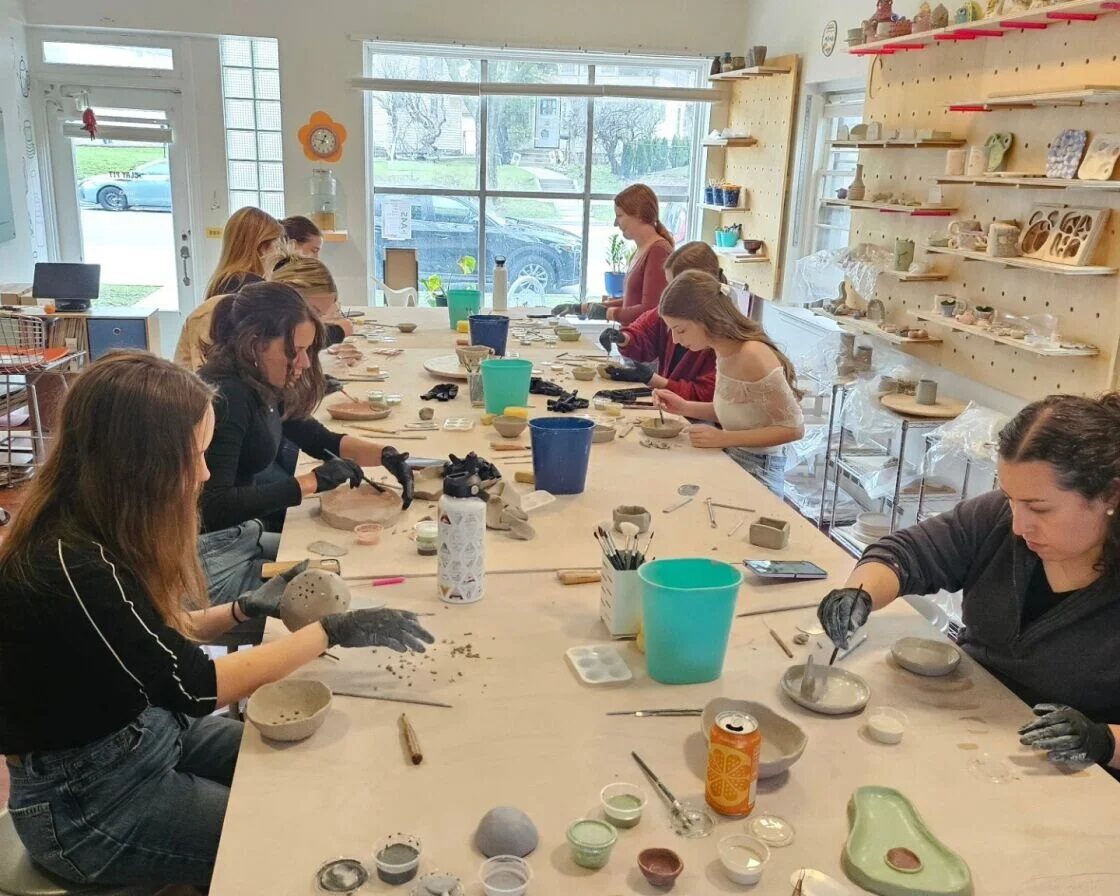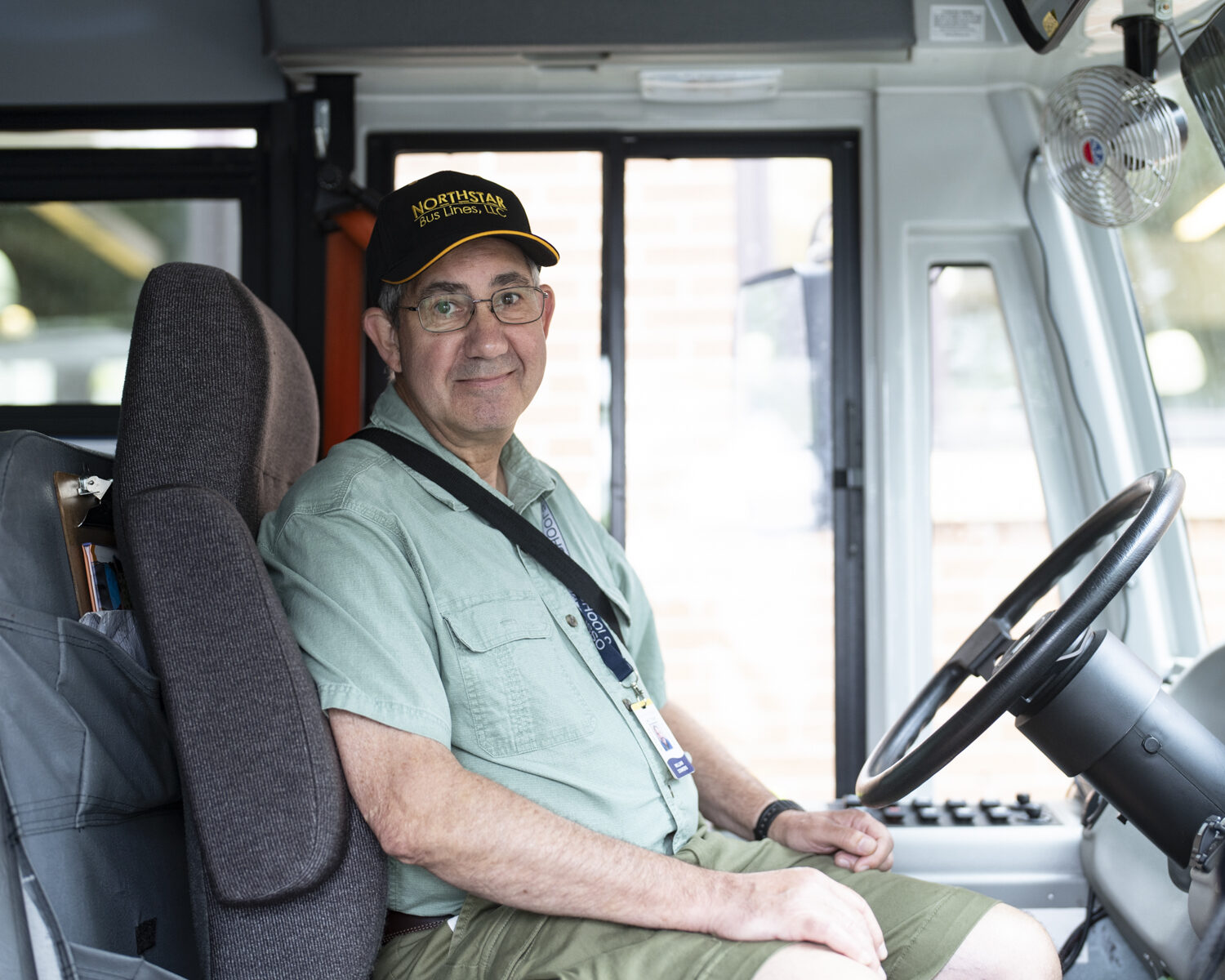BY STEPHANIE FOX
Most people in Minneapolis know that those blue trash bins, the ones next to the gray garbage cans, are the place to toss recyclables. The trucks come by every two weeks, some with side-loading mechanical arms and others with two-member teams
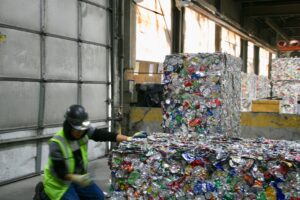
A worker checks for unwanted materials in a square of aluminum cans
with a driver and a worker who wheels the bin to the back of the hauler where it’s grabbed and unloaded. But where it ends up is, to many, a mystery.
In Minneapolis and St. Paul, the contents of those bins end up at the Eureka Recycling facility in North Minneapolis.
Eureka Recycling is a nonprofit mission-based organization, collecting and processing recycled waste from Minneapolis and St. Paul and from other waste haulers around the Twin Cities. The top brass is an all-female team, not the norm for such a facility, said Katie Drews, the organization’s co-president.
Until 2013, it was up to the residents in Minneapolis to sort their own recyclables and to put them in separate containers. But now, the blue bin is for any sort of recyclable waste and the sorting falls not on the public but on the workers at Eureka’s facility.
The trucks arrive at the Eureka warehouse where they are weighed, emptied of their items and piled into mountains of mixed waste. Weighing lets the facility determine how much of what comes in is not recyclable, with an average of about 10-11% of the haul deemed unsuitable for reuse.
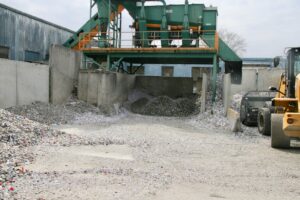
Recycling machines
Items are first put onto conveyor belts where they are sorted into categories, including unusable items. At the end of the process, usable recyclables are bundled and made ready for pickup, to be reworked into new products.
The facility collects from 350 to 500 tons of material each day.
“It’s dangerous work,” said Drews, “but we pay a living wage. Our workers are full-time and work four 12-hour days with three days off, so workers get a consistent amount of overtime.”
Employees stay at a line location for one to three hours, then move to a different position in order to avoid fatigue and repetitive stress injuries. Eureka has a high retention rate, with some workers staying for more than 20 years. Eureka’s drivers and maintenance teams are unionized.
Workers first sort the material by size, weight and shape, grabbing items off the conveyer belts, looking for problem materials that can’t be recycled, including milk cartons, juice boxes, diapers, black bottles and Styrofoam. These are discarded, to be sent to landfills and the city burner.
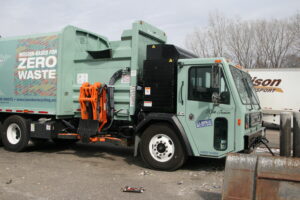
Eureka’s new electric hauler
Inside, it is very loud. There are the machine engines and then the sound of thousands of glass containers crashing down to the floor below. There are robotic arms grabbing items. An optical sorter can process 1,000 pieces of material a minute.
Not everything collected is usable and some things can cause major mechanical and safety problems.
Problems are caused by items such as holiday lights, extension cords, garden hoses and plastic bags, which can wrap around equipment. “We have to shut down the line a couple of times a day because of this,” said Drews.
Even more dangerous are lithium batteries. Even tiny ones can combust and cause a fire in the facility. “Take them to hazardous waste,” Drews said, “along with helium tanks and gas cans.”
About 20% of what Eureka takes in are hard plastics. Most are acceptable, but black plastic is too hard for the machines to sort and is not accepted. Six-pack yokes, the flat plastic pieces that can hold six packs of soda or beer cans together, are difficult for the sorter to recognize.
Colored plastic is less valuable than clear plastic, and now a few companies are starting to change their packaging to make it better for recycling. (Recently, the soft drink Sprite changed from green bottles to clear.)
Drews says they are trying to keep the business local.
The recycled paper and cardboard they recover are made into cereal and cracker boxes in St. Paul. Glass bottles and jars are sorted by color in St. Paul with clear glass ending up in Shakopee to be made into bottles for drinks, pickles, salad dressing and other foods.
Plastic milk and laundry detergent containers become landscaping, decking and fencing. Many plastic drink bottles are made into new plastic containers.
“We are creating material for someone local to use, with 75% staying in Minnesota and 85% staying in the Midwest,” Drews said.
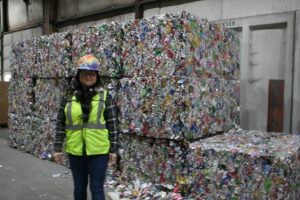
Katie Drews in front of bundles of aluminum cans ready to be repurposed
So what should good citizens who want to recycle properly do?
The most valuable items are large cardboard boxes. The box should be the size that could fit in the blue recycle bin. Break them down if possible, Drews said, but if it’s not possible, leave them by the blue bin to be picked up.
Keep lids on larger glass bottles instead of removing them. When the bottles are broken, these lids can be separated but an already separate lid can be hard for the workers (and the machines) to find. Smaller metal lids, the kind found on wine bottles or condiment bottles, should be removed and put in the trash. Keep plastic lids on plastic containers as well.
Clean out food containers (you don’t need to scrub them) as a consideration to the workers. Check plastics for the recycle number. Acceptable plastics are #1, #2 and #5. Clean aluminum foil should be crumpled into two-inch or larger balls.
Mail with the see-through windows and items with paper labels are acceptable. Stick Post-It notes on other paper items. Check with your local supermarket – some collect soft plastic bags to send to recycling facilities that make other plastic bags.
There are no national rules for recycling, with each locality creating its own. In Minnesota, the goal is, by state statute, to reach a 75% recycling rate by 2030. The Hennepin County Board of Commissioners has the same goal for the county, in order “to enhance the health, safety and quality of life of our residents and communities in a respectful, efficient and fiscally responsible way.”
Eureka is also moving ahead and has begun to add AI and to explore solar energy to help power the facility. They recently added the first electric truck to their fleet and hope to add more soon.






